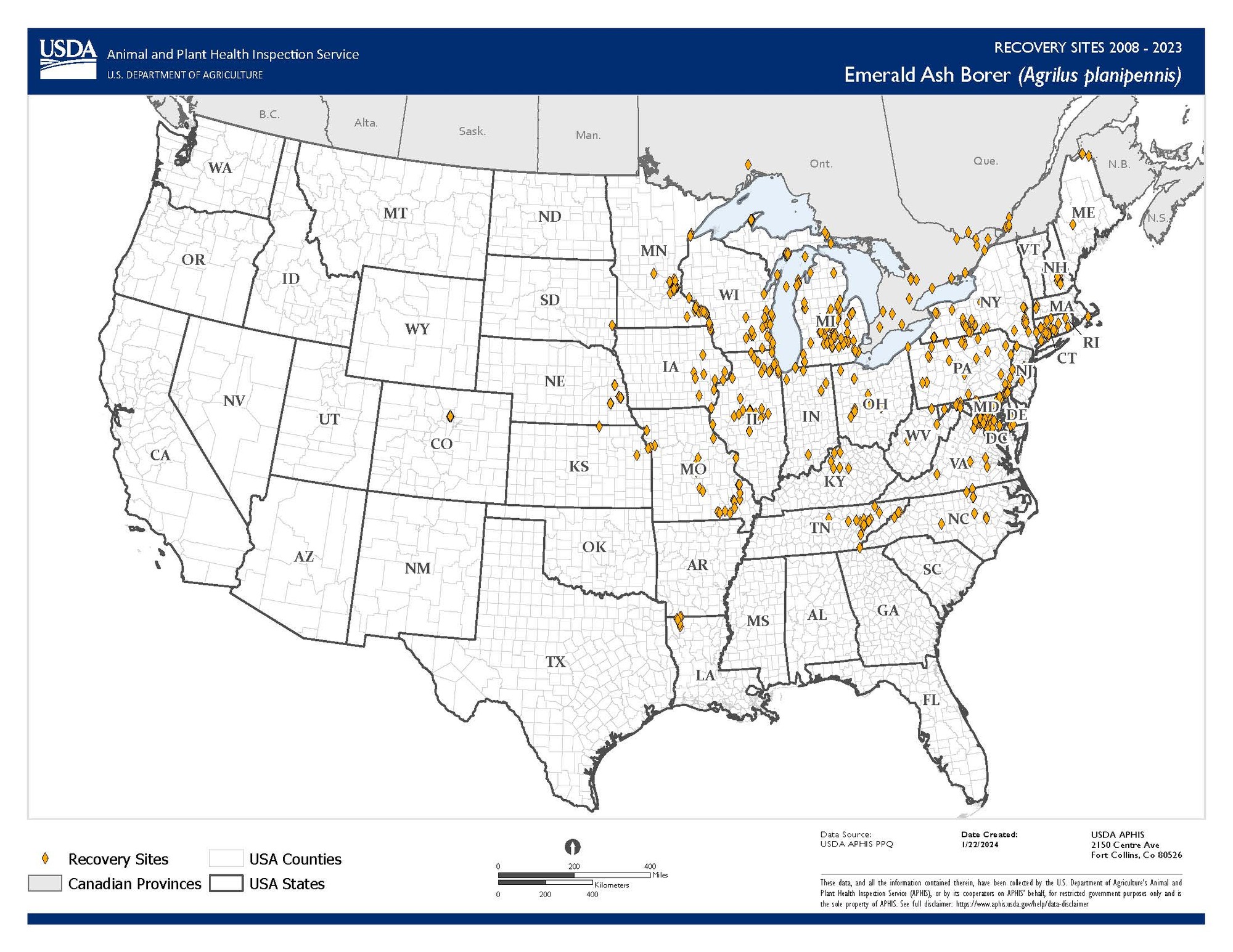USDA's Emerald Ash Borer Program Report Update
USDA Animal and Plant Health Inspection Service sent this bulletin at 06/12/2024 11:45 AM EDTHaving trouble viewing this email? View it as a Web page. ![]()
You are subscribed to Emerald Ash Borer Program Report for USDA Animal and Plant Health Inspection Service.

June 12, 2024
USDA’s Animal and Plant Health Inspection Service (APHIS) works with Federal, State, and other partners to detect and manage known emerald ash borer (EAB) infestations. The EAB program uses biological control and ongoing research to minimize the impact from an infestation and maintain ash as a viable part of the American landscape. This report provides the most current information on EAB program efforts.
Announcements
Juli Gould Retires on June 30th
It's with a bittersweet sentiment that the EAB program announces Juli Gould’s retirement, effective June 30th. Juli's departure signifies a pivotal moment for the program. Her work researching biological control agents to help manage EAB populations has proven to be invaluable. It has led to the four parasitic wasps the program uses today. The EAB program wishes Juli the best as she embarks on exciting new endeavors. With Juli’s departure, APHIS Biological Scientist, Christine Dodge, will assume EAB biological control research work. Christine can be reached at Christine.Dodge@usda.gov.
Data Entry Reminder
Remember to enter release and recovery data into MapBiocontrol. Release data should be entered the same day as the release. Recovery data should be entered as soon after sampling as possible. Remember to include the Recovery ID number for all specimens submitted for identification. Input zeroes if you do not find anything. If you have questions, please contact Release Coordinator, Scott Whitehead at 810-844-2708.
Send Photos
APHIS is looking for photos showing fieldwork during the release season. Photos can be of people placing ash tree bolts or containers on trees, felling and debarking activities, or something similar. You can use a cell phone to take photos. Photos should be yours and not photos that APHIS needs third-party permission to use. Please email the original or large size of the photo to: eab.biocontrol.program@usda.gov.
EAB in the United States
EAB is in 36 states and the District of Columbia: Alabama, Arkansas, Colorado, Connecticut, Delaware, Georgia, Illinois, Indiana, Iowa, Kansas, Kentucky, Louisiana, Maine, Maryland, Massachusetts, Michigan, Minnesota, Missouri, Nebraska, New Hampshire, New Jersey, New York, North Carolina, Ohio, Oklahoma, Oregon, Pennsylvania, Rhode Island, South Carolina, South Dakota, Tennessee, Texas, Vermont, Virginia, West Virginia, and Wisconsin.
The image above shows where EAB biocontrol recoveries are in the United States from 2008 through 2023. Click the image or click Recovery Map for a closer look.
Biological Control
USDA uses emerald ash borer's natural enemies as biocontrol agents—these tiny stingless wasps are showing promise in terms of protecting young ash saplings in many states.
Parasitoid Releases
The Biocontrol Field Release Guidelines are newly updated for 2024. The updates provide some significant changes to release and recovery activities and now meet accessibility standards. Please remember to look for new release sites for next year while you're in the field. The deadline for next year’s site selection is December 1st. If you have questions, please contact the Acting Rearing Facility Manager Nicole Sawallich at 810-844-2704.
Recovery Trapping
Please conduct recovery trapping in at least one release site per county for two years. Process or sort the specimens found in recovery samples at your location. If you need help with sample identification, please email EAB.Biocontrol.Program@usda.gov. UPDATE: Send all suspect parasitoids for identification to this address: USDA APHIS, Attention: Andrea Anulewicz, 5936 Ford Ct, Ste. 200, Brighton, MI 48116. If you don’t recover anything within two years, consider doing more releases or recovery trapping. If you have questions, please contact Biological Scientist Christine Dodge at Christine.Dodge@usda.gov.
Release and Recovery Videos
Videos are available to watch for more in-depth information about emerald ash borer, choosing release sites and release considerations, conducting releases, and evaluating parasitoids establishment, debarking and peeling trees, and using yellow pan traps. Find the videos online at: Release Recovery Videos.
To learn more about biological control and its role in protecting ash, please read Biological Control for Emerald Ash Borer. If you have questions, please call 1-866-322-4512 or email EAB.Biocontrol.Program@usda.gov.
Research
APHIS scientists are studying how Integrated Pest Management (IPM) might be used in a forest ecosystem to significantly reduce and control EAB populations. IPM combines a variety of tools and strategies to identify, manage, and reduce risks and impacts from pests.
Maine—The EAB program now has collaborators in Maine for the Forest Integrated Pest Management (IPM) project in black ash. Researchers are starting to identify sites and tagging trees for treatment.
Trapping
APHIS is providing traps and lures to conduct surveys. You can request traps, lures, and accessories through your State Plant Regulatory Official or you order them through the Integrated Plant Health Information System (IPHIS). Please remember to enter your survey data weekly into IPHIS.
Latest Maps
Infested Counties Map (Interactive)
Additional Resources
Informational Websites
EAB National Invasive Species Information Center
Outreach Materials
Contacts
EAB National Policy Manager
Ron Weeks, 919-559-4311, Ron.D.Weeks@usda.gov
EAB National Operations Manager
Russ Bulluck, 919-855-7182, Russ.Bulluck@usda.gov
If you think you’ve found EAB or signs of infestation, record the area where the specimen was found and take digital pictures of the insect and tree damage. Submit your report to your State Plant Health Director or email Report.EAB@usda.gov or call the EAB hotline at 1-866-322-4512. Thank you.



